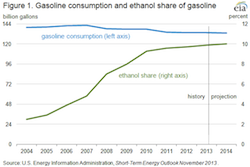A recent Today in Energy published by the U.S. Energy Information Administration (EIA) reviewed the Environmental Protection Agency’s (EPA) proposed rule for the 2014 Renewable Fuel Standard (RFS). The RFS program, established by the Energy Policy Act of 2005 and later expanded by the Energy Independence and Security Act of 2007 (EISA07), requires EPA to set annual requirements for the renewable content of liquid fuels that may differ from a set of targets specified by law.
 The U.S. Energy Information Administration is required by the RFS provisions in EISA07 to provide EPA with information related to the projected use of motor gasoline and diesel fuel and the supply of various categories of biofuels in the month prior to issuance of EPA’s final RFS rulemaking for each program year.
The U.S. Energy Information Administration is required by the RFS provisions in EISA07 to provide EPA with information related to the projected use of motor gasoline and diesel fuel and the supply of various categories of biofuels in the month prior to issuance of EPA’s final RFS rulemaking for each program year.
While EPA has set requirements for cellulosic biofuels well below the legislated volume targets for such fuels in past RFS program years, the proposed rule for the 2014 RFS program is the first time that the agency is seeking to set the total renewable fuel and advanced biofuel requirements below the legislated targets.
According to This Week in Petroleum, the pool of gasoline available for ethanol blending is significantly smaller than it was projected to be before enactment of EISA07, which in addition to updating RFS program requirements also mandated significant increases in vehicle fuel economy standards. The total demand for gasoline has been flat or decreasing since 2007 because of greenhouse gas and fuel economy standards for vehicles, fuel prices, and a sharp economic downturn followed by a slow recovery. In summer 2006, when the reference case for EIA’s Annual Energy Outlook 2007 (AEO2007) was developed, the projected 2014 total gasoline energy demand (including ethanol) was 153.9 billion gallons. This gasoline pool could have absorbed 15.4 billion gallons of ethanol if all gasoline was E10. By summer 2012, when the AEO2013 reference case was developed, the comparable estimated total gasoline energy demand was 131.9 billion gallons. This gasoline pool could absorb 13.1 billion gallons ethanol if all gasoline was E10.
The forecast of 2014 motor fuel use that EIA will provide to EPA for use in translating the RFS requirements it decides upon into renewable volume obligation percentages for obligated parties  under the RFS program will be based on the latest available STEO forecast at the time EIA provides its input. The November 2013 STEO projects gasoline energy demand of 133.2 billion in 2014, including 13.35 billion gallons of ethanol by volume. This estimate is about 1.0% higher than the AEO2013 reference case projection for 2014. The November 2013 STEO projects petroleum diesel consumption of 55.3 billion gallons in 2014.
under the RFS program will be based on the latest available STEO forecast at the time EIA provides its input. The November 2013 STEO projects gasoline energy demand of 133.2 billion in 2014, including 13.35 billion gallons of ethanol by volume. This estimate is about 1.0% higher than the AEO2013 reference case projection for 2014. The November 2013 STEO projects petroleum diesel consumption of 55.3 billion gallons in 2014.
Forecasts of motor fuels use over the coming year generally move with the outlook for economic conditions, prices, and any changes in regulations. However, as noted in EIA’s May 2013 letter to EPA providing input in advance of the 2013 RFS final rule, forecasting cellulosic ethanol supply can be quite challenging. While cellulosic biofuel production estimates are subject to much smaller absolute uncertainty than production or consumption estimates for other transportation fuels, the percentage uncertainty surrounding forecasts of cellulosic fuels is very large. This reflects both the very low volume of total cellulosic biofuel production and the very small number of facilities that have begun to enter into service. Small changes in the startup date or projected utilization rate at just one facility can therefore have a large effect on the total amount of cellulosic biofuel production that is achieved. This is different from many other EIA production forecasts where production occurs from a very large number of plants, which allows for averaging of outage rates at individual facilities, and for which start-up of a new facility has very little impact on the total production.
An additional challenge for forecasts of cellulosic supply during 2014 is that EPA is currently considering the approval of several new pathways (the combination of feedstocks and conversion methodology) for fuels that could affect the availability of certain types of biofuels. As it prepares to provide its input to EPA ahead of the final RFS rule for 2014, EIA will be carefully watching for new information regarding the situation with respect to individual facilities and possible action by EPA regarding new pathways over the coming months.

